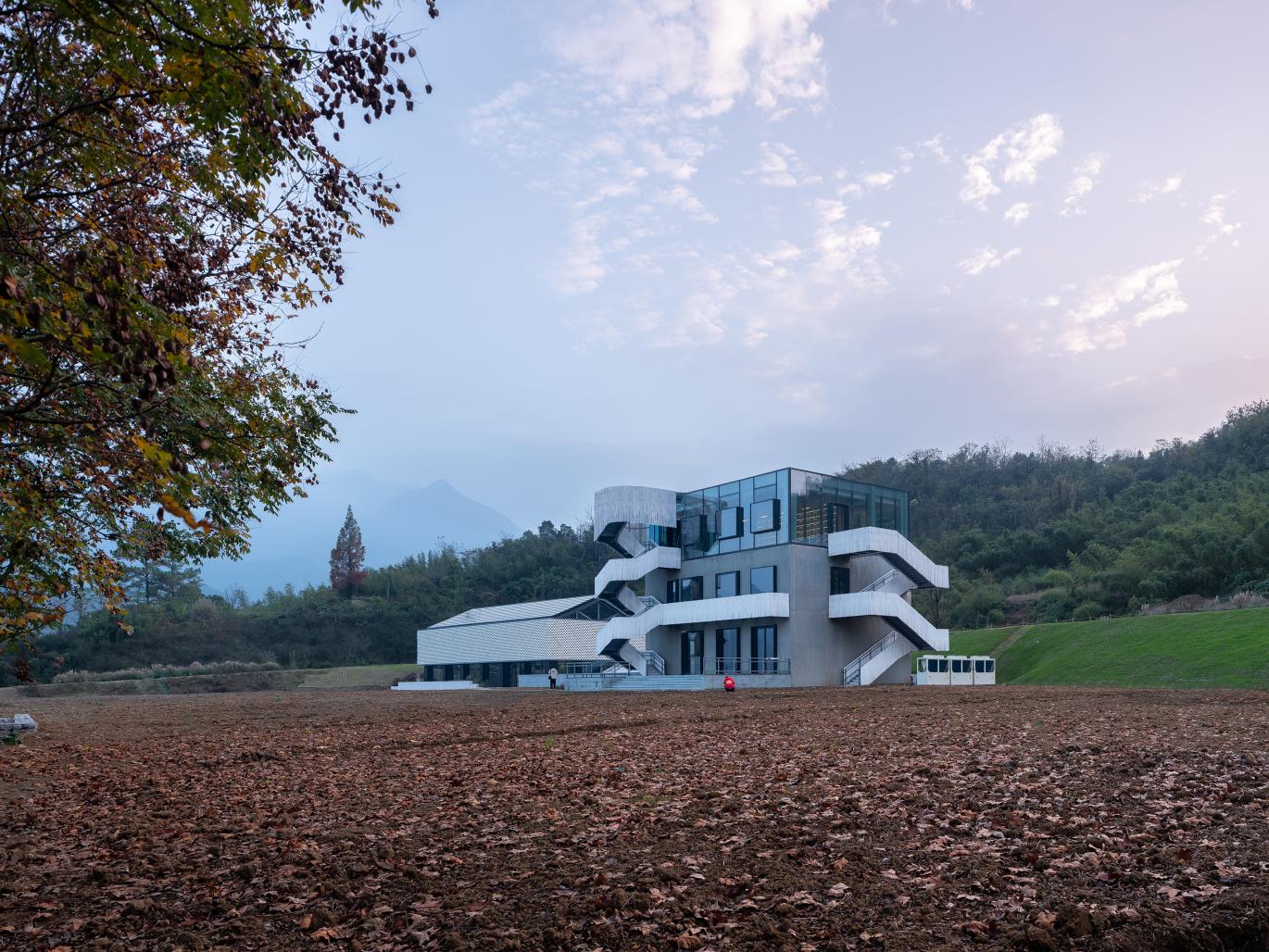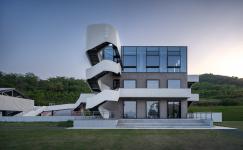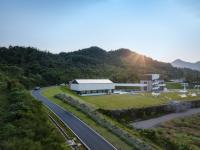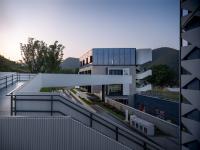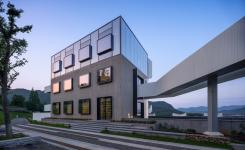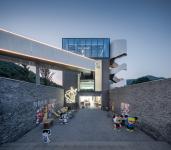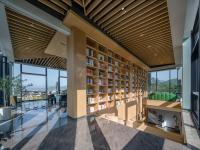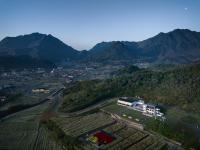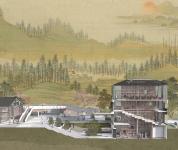Design innovation:
"Yucun Impression" Village Youth Library revitalizes a defunct rural industrial structure, incorporates it into the ecological era's growth of rural regions, and demonstrates the open and inclusive development mindset of China's rural areas against the backdrop of rural rehabilitation strategy.
The building's renovation focuses on preserving the collective memory of the area. Starting with the pastoral construction of memorial sites, the building adopts the "warranty combination" renewal strategy and combines it with locally produced, Bamboo model concrete materials to fully penetrate the collective memory from the site to the building. The interior of the building creates a continuous, open public space, breaking the conventional rural bookstore's singular function and transforming it into a rural cultural space that integrates reading, exhibitions, and activity release and can be utilized by locals, young entrepreneurs, and tourists.
In order to achieve carbon neutrality in rural buildings, Yucun Impression has tried a variety of low-carbon materials and technologies. Through practical application, carbon neutral solutions for useful buildings in rural areas were studied.
Design background:
The "two mountains" concept, which states that "green water and green mountains are golden mountains and silver mountains," was first proposed in Anjiyu Village in Zhejiang, the location of Yucun Impression. The two still-standing buildings that were originally a part of the Yucun Weishan Industrial Park have been turned into farmland and have witnessed Yucun's transformation from "industrial birds" to "ecological pastoral" in terms of green development.
Today, Yucun is a national 4A-level scenic destination.
Yucun Impression was finished in June 2022, making it China's first carbon-neutral structure. The building has several applications ,becoming the most active and innovative rural site.
Yucun's worldwide cooperation initiative is attracting an increasing number of young people. The arrival of young entrepreneurs has resulted in a clash of rural and urban cultures in Yucun, altering the traditional way of life. The characteristics of rural public buildings are also quietly evolving; they are no longer just for villagers, but require buildings with more integrated services and cultural notions that are more inclusive. As a result, the impression of Yucun is positioned as a youth library, with the hope of developing it into a complex and inclusive cultural site where villagers, young entrepreneurs, and tourists may find cultural resonance.
Building renewal strategies:
The initial role of the building was a cement plant, about 480 square meters, which is a building designed for the production of cement. The other structure is the former silk generating workshop with a steel roof truss with a two-storey space inside. The two buildings in need of renovation are small, about 100 meters apart.
Architectural renovation design must find its original element characteristics from space, form, and material, and give the two buildings unique appearance characteristics through reorganization and innovation of architectural language, as well as strengthen the dialogue and connection between the two isolated buildings. Simultaneously, the site and its surrounding natural features are involved, so that the rural industrial architecture and the local natural environment merge, completing the memory penetration from the site to the structure.
1、Site Memory: Scene Reshaping of Industrial Heritage's Collective Memory.
Starting with the location, the designers created a low-impact land theater on the existing site to recreate the lost collective memory of the countryside by man and nature. The cultivation of crops on the land is similar to the land use of the original factory building, and the transportation route of the original factory building is preserved, and people are looking for memories of the development history on the road while studying the history of Yucun. While visiting, people can participate in the production and harvest of crops, which can make people and nature have a deep resonance.
2. Building renewal: "warranty combination" adaptable update to satisfy the needs of cultural memory and use.
The architectural renovation design adheres to the maxim "minimum intervention, maximum benefit," extracts and retains the inherent formal memory of the original building, incorporates these memories into new scenes, and realizes the sustainable protection and renewal of the building by using the most intuitive form as the medium of collective memory.
In architectural renovation, we focus on retaining the original cultural memory while giving more possibilities to the space. The cement factory retains the volume of the original building and the memory of the windows opening, and the upper part of the building is made more transparent so that the architectural space can integrate with the mountains, which is a metaphor for Yucun’s transformation from a cocoon to a butterfly.
The building windows are outlined on the glass façade by a 40 cm-tall metal window frame that serves as a counter and serves as a metaphor for the window of memory. The original triangular staircase form is kept on the north façade, which is then reshaped with hairy bamboo to reduce landscape blockage and make for the best viewing platform while also functioning as an outdoor evacuation to meet fire safety regulations.
The underground space of the former cement factory excavated the sunken courtyard and activity space to further excavate the use of the building Value.
The four-story building preserves the number of original structures and the memory of opening windows, figuratively alluding to the development process of Yucun's "turning into a butterfly". Since the upper part of the building is made of glass, it is more translucent and blends in with the surrounding farms and mountains. To make the most of the available space, the cement plant building added basements and underground courtyards.
Functionally, as an important carrier of future education and neighborhood scenes, the original cement factory space will be empowered into a future library. The interior space retains the original two partition walls as the main diversion inter face of the space ,and is transformed into a bookshelf wall, continuing from the ground floor to the top floor. The stairs also serve as a reading and communication space, revolving around the bookshelf wall, circling upwards, connecting the upper and lower, inner and outer spaces. It is also a metaphor that in the future, rural knowledge can be obtained everywhere. The future villagers are new educated youth. The place for them to interact and gather is not only in the fields, but also in beautiful nature landscape and zero-carbon library. In addition to serving as a transportation space, the staircase is a gathering place for tourists, young people and locals where people can read, talk and arrange activities.
The original wire drawing factory is built into a rural art exhibition hall, which becomes the most important exhibition and release in Yu village.
Lightweight perforated aluminum sheet material is used to recreate the historic openwork facade in order to encourage permeability in both inner and outdoor spaces.
To establish communication and connection between the two buildings, the designers constructed a sunken plaza that connects the basement of the former cement factory building. The plaza can act as a public gathering place for people to unwind, congregate, and perform between the two buildings as well as guide traffic from the square to the basement level.
The supplementary corridor connects the two buildings in series, making the two originally isolated buildings connect, lessening the impact of the height difference of the site on the building, and building a complete pedestrian flow line. In this way, an overall connection between buildings and roads, farmland and the terrace is established, and the overall site space is activated. Corridor also become a dynamic corridor for site interaction. Finally a landscape space surrounded by ground squares and air corridors is established where people can walk around, touch and feel the charm of the space.
With multiple first-floor design techniques, the Yucun Impression Youth Library begins with the purpose of the building and aspires to foster more social scenes. By opening multiple entrances and exits in the ground square, sunken courtyard, and second-floor corridor, users can enter the building conveniently at various heights and directions, providing the best possible space experience.
3、Local material: combination of bamboo and concrete
Yucun impression material is a rebirth of the industrial era's memory. Local bamboo is used as a model and poured with concrete to make bamboo mold concrete, which is used as the major material for the building's wall. The external staircase and corridor rails are built of hairy bamboo from the mountain, creating a textural appearance that matches the bamboo molded concrete.
4、Full life cycle platinum low-carbon building
The advancement of technology and materials has resulted in zero carbon emissions, as well as the exploration and practice of the future development direction of rural zero-carbon construction. The photovoltaic glass component is installed on the building's roof, and the electricity generated is used to power the opening of the glass curtain wall.
Solar collectors are mounted on the roof, and the heat generated is used for solution regeneration in the dehumidification system. Ventilation shafts are installed on the bookshelves to provide hot pressure ventilation using a combination of ventilation and wind pressure ventilation.
Yucun Impression fulfills the transformation of rural industrial buildings into low-carbon buildings, establishing a new standard for rural design progress.
Building use value:
Following the building's reconstruction, the Youth Library and the National Comics-themed Coffee Shop opened, became the most popular destination in Yucun. Tourists, young people, children, and relaxing residents congregate here. Continuous use keeps building spaces changing. Designers monitor the building's business needs and update the building's spatial components on a regular basis to assure the project's sustained use value.
While operating in Yucun Scenic Area, various cultural and creative activities are regularly held here, including Yucun Global Partners, Youth Forum, Comic Photography Exhibition, Year-end Bonus Conference, Midi Music Festival, etc., attracting a large number of young tourists.
These two industrial heritage buildings have been fully integrated into the operation of Yucun Scenic Area, becoming the most active place.
2021
2022
Location: Yucun Village, Anji County, Zhejiang Province, China
Year of Construction: 2022
Client name: Yucun Impression
Floor area: 1622.8 square meters
Cost: 2,834,000$
Construction: People's Government of Tianhuangping Town
Architecture Design: Shanghai Jiao Tong University;Zhongcheng Keze Engineering Design Group Co., Ltd ;Zhejiang Tianyue Engineering Management Co., Ltd
Architecture Design Team: Chunyu Du , Lingjun Jin , Wowo Ding , Ji Yang , Jie Zhang , Jianyun Huang, Yuanyuan Wang ,Ye Xu
Sturcture Engineer: Qingyue Meng
Mechanical Engineer: Lingjun Jin
Electrical Engineer: Ji Yang
Photographers: Qingshan Wu

